Vol 4 No. 50 TROPIC LIGHTNING NEWS December 15, 1969
Index
| Quality Of Honor; A Message From General Hollis We read a lot in the papers today about the bestiality of war in Vietnam and of the fact that some Americans have succumbed to those base instincts leading to the wanton killing of innocents. But this is not the mark of performance on the part of the overwhelming majority of our soldiers who, in a complex and difficult war against an elusive and designing enemy, have sought fiercely to do their job with honor, purpose and skill; and with wholesome initiative. One cannot commit atrocities and be an effective soldier. The committing of atrocities does not make a unit "gung-ho". A commander cannot order the commitment of atrocities and be a dynamic commander. We all know this. We all know too that each thinking member of the Army must observe the rules of war and not abuse them if he is to meet fully the obligations of his mission. While it is unfortunately true that on occasion we have killed and maimed non-combatants with our fires -sometimes as a result of "on-the-spot" judgments - the requirements of our individual corporate consciences demand that we do all within our power to minimize the harm done to them as we undertake to protect our men. As I have gone about the 25th Division I have seen this concern for the innocent civilian to an overwhelming degree. It is a concern that must continue to govern our conduct in this difficult war. Because this is a complex war, and because the enemy exploits the innocents, we have devised extensive and detailed rules of engagement, all designed to minimize trauma to those innocents who may be incidental to the battlefield. These rules must be observed by all. At a time when alleged abberations of conduct by some American soldiers hold full sway in the journals across the land we must re-dedicate ourselves to this quality of honor so that the confidence of our people may be fully secured in the difficult days ahead. There is no substitute for it. Without honor, integrity and compassion we are nothing. Let us accomplish our mission purposefully and dynamically in this light. You have my loyalty and support. Harris W. Hollis Major General, USA Commanding |
Regulars, RVNAF Crumple NVA Camp
By SGT K.C. CULLEN
TAY NINH - Speed and coordination of elements in the air and on the ground
spelled success for Regulars of the 3d Battalion, 22d Infantry and the RVN Air
Force as they blasted the enemy's attempts to establish a base camp near the
Cambodian border west of Tay Ninh City.
A forward air controller spotted a tracked vehicle coming across the border
and the Vietnamese Air Force was called in to destroy it. They were successful,
and then it was the turn of Charlie Company of the Regulars to find out what was
in the area.
THE REGULARS were inserted by slicks within four hundred meters of the border
in quick reaction to the situation. Speed was of the essence and the
infantrymen rapidly deployed, found the beginnings of the base camp and moved
through. Pigs, chickens, bags of rice and many trails marked the area, but the
enemy had fled. Four tons of rice were found.
A small element of the Regulars were off to the flank of the main body and
engaged seven enemy who were attempting to enfilade Charlie Company.
"All of a sudden, they were in front of us and we opened up," said Specialist
4 Mike Marcum. "Two went down immediately and the others broke and ran. Bruce
(Specialist 4 Bruce Hahn) wounded another as he opened up with his 60."
THREE SKS RIFLES were left behind, along with 71 Chicom 60mm mortar rounds
and 20 hand grenades. These were blown by engineers before the Regulars were
extracted from the area.
Efficiency, top coordination and immediate evaluation by Captain Norman F.
Sligar, Charlie Company commander, allowed the entire mission to be accomplished
in a minimum of time. The Regulars spent less than an hour and a half crimping
yet another VC/NVA staging area in Tay Ninh Province.
Warriors Silence Noisy NVA
Boi Loi 'Bush Trips Up 12
By SP4 JEFF HINMAN
CU CHI - In a recent night operation, the second platoon of Delta Company, 2d
Battalion, 12th Infantry left its night laager position located in the once
enemy-infested Boi Loi Woods to set up an ambush that would cost the NVA 12 of
its troops.
The Warrior platoon was organized into an L-shaped ambush formation near the
intersection of two trails. At 1914 hours, a call was put in to Fire Support
Base Pershing.
The platoon was about to engage an unknown-sized enemy force.
Sergeant Randy Isbell of Themaston, Ga., said, "We had just set up for the
night when we heard them coming. They were making an awfully lot of noise out
there."
ENGAGING WHAT was believed to be the point element of a larger NVA force, the
Delta Company Warriors caught the NVA walking in the open along the trail. The
Warriors were hidden less than a hundred feet away. Ten claymore mines were
blown on the unsuspecting enemy, followed by M-16 and M-60 machine gun fire.
The enemy returned fire with hand grenades and some AK-47 rounds. First
Lieutenant Dale Butcher of South Dayton, N.Y., the second platoon leader, said,
"I counted 15 holes around my position where hand grenades had gone off."
By 1930 hours contact with the enemy had broken. The Warriors swept the kill
zone finding nine NVA dead, six AK-47 rifles, and a number of blood trails.
But according to Private First Class William Abbot of West Haven, Conn., the
danger was still not over. "The third NVA body we found had been
booby-trapped. The soldier had pulled the pin on a hand grenade and placed it
under his body just before he died," he said.
BUTLER ALSO said, "Our Kit Carson scout saved us. He was the first man in on
the sweep. He found the booby-trapped body."
At daylight, the Warriors returned to the site of the successful ambush.
There they found three more dead NVA. This brought the total of enemy killed in
the action to 12. The Warriors also discovered one more AK-47 rifle, bringing
the total of enemy weapons captured to seven.
Deuces, Arty Down 19
TAY NINH - Artillery and mortars forced the NVA to leave 19 bodies of fallen
comrades behind after an ambush patrol spotted about 40 NVA crossing an open
field in the upper Boi Loi Woods about a mile from Fire Support Base Wood III.
Members of an Alfa Company. 2d Battalion (Mechanized), 22d Infantry ambush
patrol remembered an artillery marking round going off over the open field about
300 meters from their night location. Thirty minutes later, 40 NVA were spotted
going across the field under another marking round over the same area.
Artillery from Charlie Battery, 7th Battalion, 9th Artillery from Wood III,
Charlie Battery, 7th Battalion, 11th Field Artillery from Fire Support Base
Hunter, and 81mm mortars from the Alfa Company, Triple Deuce night laager in the
Boi Loi were called in on the enemy.
A sweep the next morning revealed the 19 NVA bodies. Not a single shot from
small arms had been fired.
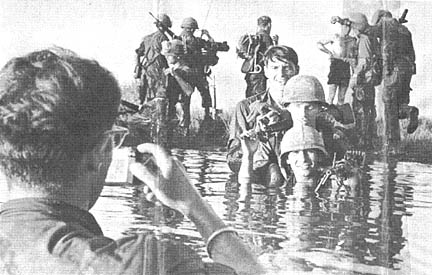 |
| HOLD IT, I want to get a picture for the folks; they'll never believe me if I tried to tell them. Following the ancient oriental axiom - one picture worth thousand words - an infantryman of Bravo Company, 2d Battalion, 27th Infantry does a little photographic letter writing during operations in a swollen stream near the Cambodian border. (Photo by SP4 Craig Sampson) |
Cav Solves Parking Problem, Fools Foe
By SGT TONY CAMELIO
CU CHI - Similar to an infantry unit in that it sets out claymores, has
all-around security, and uses M-16s and M-60s, a mechanized unit's ambush has
one big dissimilarity that causes a problem to arise: finding a suitable place
to hide its huge armored personnel carriers and Sheridan assault vehicles for
the ambush.
The solution? Do what Charlie Troop, 3d Squadron, 4th Cavalry did. Simply
leave your vehicles right out in the middle of an open rice paddy. Using such
shrewd diversionary tactics, the Raiders accounted for nine enemy dead during a
night ambush in the Citadel area, six miles northwest of Cu Chi.
SETTING UP their four-vehicle ambush not more than 1000 meters to the left of
the 10th ARVN Cavalry's night offensive position, the Raiders caught the NVA
thinking they had passed any ambushes the ARVNs may have set up.
Specialist 4 James Graybeal of Toughkenamon, Penn., was the first to catch
sight of the approaching enemy through his starlight scope.
"THERE WERE at least 30 people moving from right to left about 300 meters to
our front," said Graybeal. "I hesitated for a moment, thinking it may have been
an ARVN ambush going out, but when I realized that the ARVN probably wouldn't
have been wearing shorts with no shirts or hats, I went around waking everyone
up."
The ambush was sprung by firing a canister round from the main gun of a
Sheridan assault vehicle, with M-50 and M-60 fire opening up almost
simultaneously.
THE ENEMY quickly scattered in all directions while the Raiders continued to
bring devastating fire upon them.
A light fire team and artillery support from Fire Support Base Pershing was
also called in to help the Raiders.
A sweep of the area the following day revealed the nine enemy dead and three
AK-47 rifles. The ARVN Cavalry, sweeping 300 meters further to the front of the
ambush site, found numerous freshly dug graves.
Page 2 TROPIC LIGHTNING NEWS December 15, 1969
Decorated
| SILVER STAR | |
| 1LT Norman Alexander, Co B, 2d Bn, 22d Inf | SSG Douglas Conn, HHC, 4th Bn, 23d Inf |
| DISTINGUISHED FLYING CROSS |
|
| LTC Donald O. Crutchley, HHC, 2nd Bn, 14th Inf CPT James F. Collins Jr., Co A, 25th Avn Bn CPT Jack E. Dopler, Co B, 25th Avn Bn CPT Robert C. Shlikas, Co B, 25th Avn Bn 2LT John L. Evans, D Trp, 3d Sqdn, 4th Cav WO1 Dennis D. Collett, Co B, 25th Avn Bn WO1 Bobby J. Davidson, Co B, 25th Avn Bn WO1 Michael Finnigan, Co B, 25th Avn Bn WO1 Robert R. Forringer, D Trp, 3d Sqdn, 4th Cav WO1 Tim Horrell. Co A, 25th Avn Bn |
WO1 Marcus A. Kempson, D Trp, 3d Sqdn, 4th Cav WO1 Bobby J. Lawson, Co B, 25th Avn Bn WO1 Randolph Meade II, D Trp, 3d Sadn, 4th Cav WO1 Robert V. Rector, Co B, 25th Avn Bn WO1 Richard M. Singer, Co B, 25th Avn Bn CSM Charles M. Rutledge, HHC, 2d Bn, 14th Inf SGT Dennis R. Sarff, Co B, 25th Avn Bn SGT Marvin R. Watts, Co B, 25th Avn Bn SP4 David E. Horton, Co B, 25th Avn Bn SP4 James C. Smith III, Co B. 25th Avn Bn |
| SOLDIER'S MEDAL |
|
| MAJ Raymond L. Stearns, HHC, 25th S&T CPT Jerry L. Sawaya, D Trp, 3d Sqdn, 4th Cav CPT Charles V. Smoot, HHC, 25th S&T SSG James Higginbotham, Co A, 2d Bn, 34th Armor SP4 John A. Banuat, HHC, 25th S&T |
SP4 William M. Carrasco, Co A, 25th S&T SP4 Paul T. Drake, HHC, 25th S&T SP4 Richard H. Simmelink, Co B, 25th S&T SP4 Roy J. Wygant, Co A, 25th S&T PFC Patrick J. Meyer, Co B, 25th S&T |
| BRONZE STAR FOR HEROISM |
|
|
COL Ennis C. Whitehlead, HILC, 2d Bde MAJ Dexter A. Brancome, HHC, 2d Bn, 14th Inf MAJ James B. Maharrey, HHC, 2d Bn, 34th Armor CPT John W. Aljets, Co C, 4th Bn, 23d Inf CPT Michael J. Neuman, Co C, 2d Bn, 12th Inf CPT Marvin L. Tieman, Co A, 2d Bn, 34th Armor CPT Hiram N. Wolfe, Co D, 2d Bn, 12th Inf 1LT Harry Walter, Co, A, 1st Bn, 27th Inf 2LT Terrence M. O'Connell, Co D, 2d Fl-i, 12th Inf 2LT Michael P. Pate, Co A, 2d Bn, 34th Armor 2LT Dennie R. Shelton. HHC, 4th Bn, 23d Inf SSG Marcus C. Fisher, HHC, 2d Bn, 34th Armor SSG Coy R. Jackson. Co A, 2d Bn. 34th Armor SSG Charles R. Perkins, Co C. 1st Bn, 5th Inf SGT Roy C. Booth, Co A, 2d Bn, 14th Inf SGT Michael F. Butler, Co A, 1st Bn, 5th Inf SGT Michael H. Ikegami, Co C, 2d Bn, 12th Inf SGT Ronald Krienbroink, Co E, 1st Bn, 27th Inf SGT John A. Krolczyk, Co C, 2d Bn, 14th Inf SGT Doane M. Meighen, Co C, 2d Bn, 14th Inf SGT William F. Murphy, Co C, l. st Bn, 5th Inf SGT James P. Overby, Co A, 2d Bn, 14th Inf SGT David Pollard. Co A, 2d Bn, 34th Armor SGT Victor S. Stanley, Co A, 2d Bn, 34th Armor SGT Domingo S. Taianao, Co E, 1st Bn, 27th Inf |
SP5 Phillip Humphrey, Co B, 2d Bn, 14th Inf SP5 Mark A. Samsonas, Co C, 1st Bn, 5th Inf SP5 Wiliam Schasteen, Co A, 2d Bn, 34th Armor SP4 Michael Bouchard, Co E, 2d Bn, 12th Inf SP4 Bobby L. Broadnax, Co A, 1st Bn, 5th Inf SP4 Ernest A. Ealy, Co E, 2d Bn, 14th Inf SP4 Larry J. Freeze, Co C, 2d Bn, 14th Inf SP4 Robert L. Naylor, Co A, 2d 34th Armor SP4 Jaime Russo, Co D, 2d Bn, 14th Inf SP4 Roger L. Seay, D Trp, 3d Sqdn, 4th Cav SP4 Duane R. Siefert, Co A, 2d Bn, 14th Inf PFC Robert Draughn Jr., Co A, 2d Bn, 14th Inf PFC John C. Fazende, HHSB, 3d Bn, 13th Arty PFC Patrick Gleaton, Co A, 2d Bn, 34th Armor PFC Billy D. Howerton, Co A, 1st Bn, 27th Inf PFC Michael Kemp, Co A, 2d Bn, 34th Armor PFC Stephen J. Legarra, Co D, 2d Bn, 14th Inf PFC Burt Leroy, Co D, 65th Engrs. PFC Victor J. Ortega, Co A, 2d Bn, 14th Inf PFC Robert S. Ryken, Co A, 2d Bn, 14th Inf PFC Michael J. Stark, Co A, 2d Bn, 14th Inf PFC Donald Stefanski, Co A, 2d Bn, 34th Armor PFC Rodney Waite, Co A, 2d Bn, 34th Armor PFC Thomas Nicholson, Co A, 2d Bn, 14th Inf |
| AIR MEDAL FOR HEROISM |
|
| CPT Kenneth D. Blake, 1st Bn, 8th Arty CPT Terry E. Cory, 25th Div Arty 2LT Jon R. Deckard, 25th Div Arty CW2 Jack C. Bryant, Co A, 25th Avn Bn |
SGT Harrison C. Scogin, D Trp, 3d Sqdn, 4th Cav SGT David J. Vedder, HHC, 2d Bn, 14th Inf SP5 Robert M. Johnson, D Trp, 3d Sqdn, 4th Cav |
Is Saigon Tea Worth It?
Managing Money Matters
One of the unpleasant side effects of the war that falls almost exclusively
on the Vietnamese people is the inflation touched off by the presence of nearly
half a million free-spending American troops.
Since 1966, enough extra money has found its way into the local economy
through Saigon tea, porcelain elephants, short-timer sticks and the like to push
up the price of rice more than 200 percent, chicken more than 150 percent, and
the all-important nuoc mam sauce is up almost 300 percent.
FREE SPENDING on the local economy hurts countless people. There are better
ways to manage your money while in Vietnam.
The Uniformed Services Savings Deposit Program, for one, is perhaps the best
savings program in the world, and it is available only to US servicemen
overseas.
A class S allotment or a cash deposit at the finance office is all that's
needed to take advantage of the 10 percent interest rate compounded quarterly.
Money cannot be withdrawn while you are overseas except in an emergency, but you
can arrange to leave it in an extra 90 days after you DEROS to take advantage of
an extra dividend.
SAVINGS BONDS, purchased regularly through an allotment, represent an
investment impossible to beat. The interest rate will soon be upped to five
percent, and a saving bond program allows you to buy Freedom Shares, treasury
notes which pay a higher rate and mature in only four years from the date of
purchase.
No where in the States can you open a checking account that will pay interest
on its balance. But in Vietnam's banking facilities for American servicemen,
the government has arranged for servicemen to be able to open checking accounts
with no service charges or charges for personalized checks.
ACCOUNTS WITH a balance of more that $100 earn five percent interest. You
still can have cash when and where you need it and keep the advantages of a
savings account.
If you want to continue to make regular payments to your bank account in the
world or have your payments on an insurance policy, automobile or home,
automatically taken care of, the Army finance center will mail the checks for
you monthly. All you have to do is arrange for the proper Class E Allotment
with the finance office.
WITH ALL that money you've saved, genuinely worthwhile purchases can be made
in the PX or through the PX mail order service, which offers low prices on
Asian-manufactured products. Radios, TVs, cameras, watches and audio equipment are offered for sale at
prices far below Stateside.
YOU CAN EVEN have a discount priced new car of your choice waiting for you
when you return home.
Your memories of Vietnam can include a new car, a stereo tape system, a
camera and a solid bank account - items of lasting function and enjoyment.
Can you say the same for a few Saigon teas, several good times and a
short-timer stick?
| Pssst! Hey GI SAIGON - Be advised that United States brand name products including watches, purchased outside of exchange channels in South Vietnam may be counterfeit in whole or in part. Merchandise of this nature is not covered by manufacturer warranty. To be assured of quality merchandise in its original state as certified by the manufacturer, purchase merchandise from your authorized exchange retail outlet. |
What Is The Tropic Lightning Association?
There's been a lot of talk lately about the Tropic Lightning Association.
Potential members have been asking what it is, who it's for, and what it does.
The Tropic Lightning Association is an organization established by the
authority of the Commanding General, 25th Infantry Division, for the purpose of
enhancing the prestige and esprit de corps of the Division as well as the
separate units within the Division.
MEMBERSHIP in the TLA is open to anyone currently serving with the 25th
Infantry Division or attached units in Vietnam.
Each member of the TLA receives a membership card, a membership pin in the
form of a small division crest and, upon DEROS, a combat certificate recognizing
the member's contributions to the Division in a combat zone.
ONE-HALF of a member's dues is credited to his unit and is available to the
unit for enhancing the prestige and esprit de corps of that unit. In this way,
the TLA works to directly benefit the member by returning to him a portion of
his dues in some tangible form.
The TLA also sells souvenir-type items and the 1969 25th Infantry Division
Yearbook. The profits derived from the sale of these items are used by the TLA
to promote the prestige of the Division, as well as to benefit the men of the
division. For instance, the TLA has supplied funds for the purchases of
hospital packets given to patients at the 12th Evac Hospital.
Tropic Lightning Tots
The Commanding General Welcomes
The Following Tropic Lightning Tots
To The 25th Infantry Division – As
Reported By The American Red Cross.
Born To:
| CPT Chosse Jr., 25th S&T, girl, Nov. 11 PFC Calvin Alston, Co B, 65th Engrs., boy, Nov. 24 PFC Philip Siqmon, B Btry, 5/2 Arty, girl, Nov. 27 SP4 Ernest Simpson, Co C, 4/23 Inf, girl, Nov. 28 PFC David L. Outlaw, HHB Div Arty, girl Nov. 28 1LT Stephen R. Simon, Co A, 1/27 Inf, girl, Dec. 2 CPT Joseph A. Kilbane, NHC 3d Bde, boy, Dec. 4 CPL Harold Freeman, D Btry 3/13 Arty, girl, Dec. 4 SP4 Rodney Harvey, Co C 65th Engrs, girl, Dec. 4 |
The TROPIC LIGHTNING NEWS is an authorized publication of the 25th Infantry Division. It is published weekly for all division units in the Republic of Vietnam by the Information Office, 25th Infantry Division, APO San Francisco 96225. Army News Features, Army Photo Features, Armed Forces Press Service and Armed Forces News Bureau material are used. Views and opinions expressed are not necessarily those of the Department of the Army. Printed in Tokyo, Japan, by Pacific Stars and Stripes.
MG Harris W. Hollis . . . . . . . Commanding General
MAJ Warren J. Field . . . . . . Information Officer
1LT John C. Burns . . . . . . . . Officer-in-Charge
SP4 Harold O. Anderson . . Editor
PFC R. D. Silberblatt . . . . . . Assistant Editor
SGT John Genitti . . . . . . . . . Production Supervisor
BATTALION CORRESPONDENTS
| SP4 Dennis Bries SP4 Bill Frame SGT Bill Obelholzer PFC Jim Williams SGT Wally Baker SP4 Frank Ditto PFC Greg Stanmar SP4 Phil Jackson SP4 Pat Morrison SP5 Tony DeBiasio PFC Rich Fitzpatrick SP4 Jeff Hinman SP4 Ken Fairman |
2/22 4/23 4/23 2/12 2/34 2/14 2/14 2/27 3/13 2/12 1/5 2/12 DIVARTY |
PFC Doug
Sainsbury SGT Larry Goodson SP4 Ken Barron SP4 Tony Crawford SP5 Pete Freeman SP4 Craig Sampson SP4 Richard Sears SGT K.C. Cullen SP4 Henry Zucowski SP4 Brad Yaeger PFC Frank Rezzonico SGT Tony Camelio PFC Ray Byrne |
2/77 2/12 1/8 4/9 7/11 2/27 4/9 3/22 2/22 1/27 1/27 3/4 2/14 |
Page 3 TROPIC LIGHTNING NEWS December 15, 1969
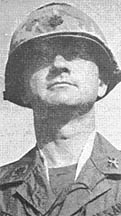 |
NEW COMMANDER of the 3d Squadron, 4th Cavalry is Lieutenant Colonel Corwin E. Mitchell of Springfield, Va., who succeeds Lieutenant Colonel Joseph R. Paluh. Mitchell previously served with DCSOPS at the Pentagon. Paluh moves to II Field Force Headquarters at Plantation. |
It's Not So Rice for NVA
Foe Denied Farmers' Harvest
By PFC A.C. ECHTONOKKER
BAO TRAI - Concentration on denying the sale of rice to the enemy and
assuring a prosperous rice harvest for the farmers of Hau Nghia Province has
become the major emphasis of the 3d Brigade pacification program.
Maneuver battalions are set up to stop infiltration of the enemy and
exfiltration of rice across the Plain of Reeds to enemy staging areas inside
Cambodia.
Security is set up to protect government check points and the more than 30
rice mills that serve province farmers.
Special emphasis is aimed at eliminating tax collection teams.
"The enemy likes to buy his rice as he goes," said Colonel William Maddox,
Jr., the 3d Brigade commander. "If he can buy rice it eliminates his storage
and supply problems."
Psychological operations have been geared to informing the farmers about the
rice support program.
First Lieutenant John McShane of University City, Mo., the brigade
psychological operations officer, said "We're telling the people to sell rice
only to persons they know are on the government side. We tell them what it will
mean to supply the enemy with food."
The rice harvest began in mid-November. It lasts through January. Each year
a harvest support program has been implemented. "This year officials are hoping
the support program will be more effective than ever.
"We know the enemy is hungrier than he has been for some time," an
intelligence officer said. "Prisoners and ralliers have repeatedly told us of food
shortages in the enemy camp."
McShane points out the economic benefits of a successful harvest. "The
market in the province is good. The people don't need the enemy market to sell
the crop," he said. "They can see that by denying rice to the enemy they are
securing their communities and earning a good living."
"The people have a lot of bad memories about rice harvests in recent years.
Much of the rice crop was ruined by the fight against insurgents in the rice
fields. Trips to the market were made with armed convoy escorts," he said.
"Now extra care is taken to avoid crop damage during operations. The farmers
are going to the mills and markets freely. The fields are secure and prosperity
is returning," he said.
'Cat Scouts On Prowl, Find Prey
By PFC RICH FITZPATRICK
CU CHI - At first it seemed like a typical mid-afternoon sweep through
familiar territory. Then, the Scout Platoon of the 1st Battalion (Mechanized),
5th Infantry, suddenly spotted three enemy heading for cover in the bush. The
scouts engaged them with M-60 and M-16 fire. This resulted in the detention of
two suspects.
The detainees led the Bobcats from one enemy hiding to another and another
and still another. Along the way, the scouts collected an 80-pound Chicom mine,
a 60mm mortar, one light machine gun, three AK-47 rifles, one RPG-2 launcher,
six NVA ponchos, two K-54 pistols, and a .45 caliber pistol.
The following afternoon, the Scout Platoon with the 158th Regional Force
escorted rome plows of the 65th Engineers in the same area. The day's operation
resulted in the uncovering of three enemy tunnels, two RPG-2 launchers, two RPG
rounds, two claymore mines, 300 feet of trip wire, propaganda leaflets, and
medical supplies.
VC Get the Bum's Rush in the HoBo
By SP4 FRANK DITTO
CU CHI - A heliborne operation penetrating deep into the Hobo Woods proved to
be a success for Bravo Company, 2d Battalion, 14th Infantry.
Operating north of Patrol Base Hunsley, the Golden Dragon Company moved into
and through the thick underbrush. The leader of the point platoon instructed
his second file to hold up so that the two files could be brought abreast of
each other.
As the maneuver was being executed the trail file encountered three Viet
Cong. The terrified VC took off running through the underbrush, stopping only
for a moment to fire at the Dragons.
Sergeant Robert May of Buffalo, N.Y., described the action that followed.
"We heard them coming so I quickly brought my squad on line. Two of the VC ran
into our field of fire and we opened up on them. I was in a pretty good
position. I could see both squads and I directed all of our firepower on the
VC."
"I set up my M-60 and when these two VC ran into my sights, I just started
throwing the lead out. I had such a good field of fire that the enemy firepower
was completely suppressed," added Specialist 4 Wayne Luber of Butte, Neb.
When the firing stopped, the two squads made a sweep of the area. The third
VC was found hiding in the bushes.
On the following day, the detainee led Bravo Company back to the same area
and located a tunnel in which five of his comrades were hiding.
This brought the total results of the operation to two enemy killed, with six
detainees. Four AK-47 rifles, one hand grenade, and one K-54 pistol were also
captured.
Presto! Instant Patrol Base
CU CHI - Just immerse a pre-made package of beams, sandbags, and conexes in a
suitable amount of water (found almost everywhere), work the mixture over for
four hours and serve. Result: instant patrol base.
It's a gourmet's delight, especially if the gourmet is a Tropic Lightning 3d
Brigade rifleman.
Sandbags, PSP, and concertina wire are all neatly packed in a used,
non-serviceable conex. The whole kit is slung by Chinook helicopter to the site
of a patrol base.
"We used this technique on Patrol Base Handel, and it worked very well," said
Captain Ronald J. Walters of Kansas City, the 3d Brigade assistant logistics
officer.
| SOME LIGHT ON THE SUBJECT - Staff Sergeant James Barefoot of Pittsburgh fills one of several gas lanterns which will provide light for a night MEDCAP conducted by men of the 2d Battalion (Mechanized), 22d infantry. A small friend looks on in amazement. (Photo by SP4 Dennis J. Bries) |
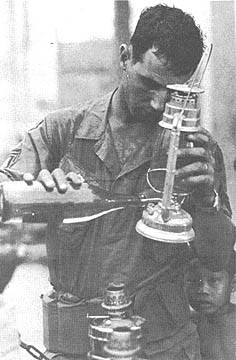 |
MEDCAPs after Dark:
Deuces Light Nights
By SP4 DENNIS J. BRIES
TAY NINH - As if daylight medical civic action programs (MEDCAPS) were not
enough, a Triple Deuce team from the 2d Battalion (Mechanized), 22d Infantry is
now running both day and night operations. Two or three nights a week the team
visits a different village to conduct night MEDCAPS.
While Specialist 5 Frankie Lane of Kansas City, Staff Sergeant James Barefoot
of Pittsburgh, and an interpreter set up in a school yard or town market,
Captain Willie Black of Columbus, Ga., and the remainder of the team are at work
elsewhere.
Kit Carson scouts serve as interpreters to announce the presence of the team
in the village and also mingle with the villagers gathering reactions of the people and
gaining information on possible enemy activity in the area.
In a recent night MEDCAP at Cau Phu, Le Van Be, a senior Kit Carson scout for
Triple Deuce, aborted an attempted Viet Cong ambush before the enemy could set
up near the school yard. He and three other Kit Carsons spotted the VC and
killed one.
In addition to medical aid provided by the MEDCAP team, other types of help
and entertainment are provided. On varying occasions, the team has put on
entertainment skits, provided movies and even television for the children.
| ALOHA LUAU - The end of November saw the departure of all Hawaiian National Guardsmen and enlisted reserves from Vietnam, and the 3d Battalion, 13th Field Artillery held a going-away luau in Cu Chi for its departing Hawaiians. Two Red Cross "doughnut dollies" serve refreshments to Specialist 4 Benedict Shimabuku (left) and Specialist 4 Charles Pa, both of Honolulu. (Photo by SP4 Pat Morrison) |
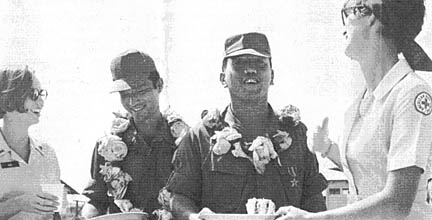 |
Page 4-5 TROPIC LIGHTNING NEWS December 15, 1969
Cliffdweller II: Closing Charlie's Mountain Resort
TAY NINH - The enemy's last major hangout in Tay Ninh Province is becoming
less and less a secure spot for him.
Operation Cliffdweller II resumed interdiction on Nui Ba Den, the Black
Virgin mountain, with Task Force Jones, spearheaded by the Regulars of the 3d
Battalion, 22d Infantry again harassing the enemy in his own rocky lair.
BRAVO and Charlie Companies of the Regulars and a Provincial Reconnaissance
Unit were the maneuver elements on the eastern face of the mountain while Alfa
Company, 2d Battalion, 34th Armor set up blocking positions at the base with a
Regional Forces Company. Bravo Company, 4th Battalion (Mechanized), 23d Infantry
stood ready at Fire Support Base Bragg, a short distance away.
Charlie Company returned to the region of the Pagoda, an old religious
shrine, where the heaviest fighting occurred during Cliffdweller I and
established a patrol base there to scour the many caves in that vicinity.
Bravo Company and the PRUs beat their way up the side several hundred meters
and then came around the side to link up with Charlie Company three days after
their eagle flight set down.
THE ENEMY did not stand and fight but fled immediately from the area leaving
only harassing forces behind the cover the retreat. All elements received only
light sniper fire throughout the mission and one enemy soldier was killed.
Countless caves were searched but little was found as the VC/NVA forces
apparently learned from the Regulars first trip to the boulder-covered slopes.
The enemy is finding it ever more difficult to return to his former haunts as
the caves that could not be destroyed were given a dose of persistent
riot-control agent. Habitable areas on the side of Nui Ba Den are becoming
virtually nonexistent.
| Photo Feature by Sgt. K. C. Cullen |
|
|
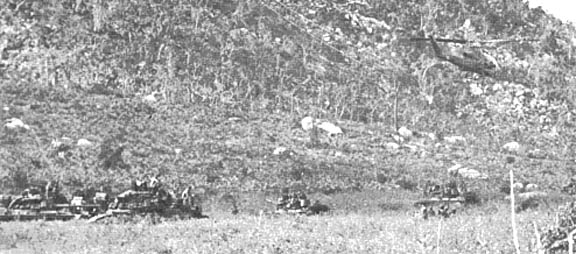 |
| Dreadnaught tanks and a Rat Pack gunship provide security at the base of the mountain. |
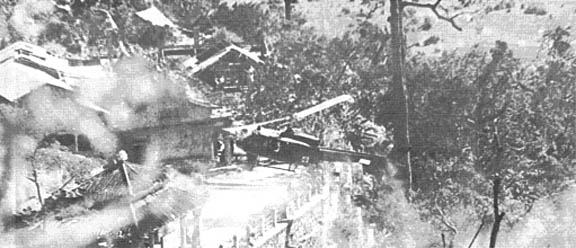 |
| With smoke from suppressive fire below, a dustoff ship lands on the mountainside to pick up the wounded. |
 |
 |
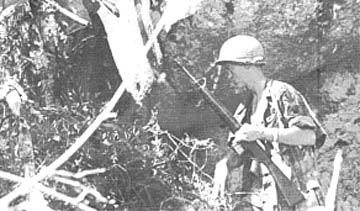 |
| A soldier cautiously checks the mouth of a cave. |
| The downhill journey nears the mountain base. |
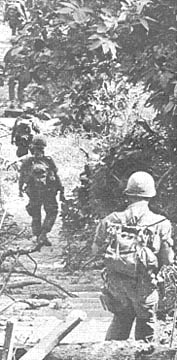 |
Page 6 TROPIC LIGHTNING NEWS December 15, 1969
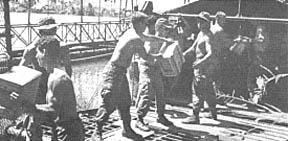 |
CHAIN GANG - Up Tight Cannoneers of Alfa Company, 2d Battalion, 77th Artillery, mustered a human chain for fast loading Vietnamese Navy boats that shipped them to Tra Cu to support Wolfhound operations west of the Vam Co Dong River. (Photo by Doug Sainsbury) |
Aided by RVN Navy
Up Tight Arty Floats cubes
By PFC DOUG SAINSBURY
CU CHI - How do you move three M-102 howitzers, men and supplies from a hard
spot to support a combined infantry operation when CH-47 Chinook helicopters
aren't available?
"When we were told that we couldn't get choppers, we had to do some quick
planning," said Major Robert D. Helmen of Louisville, Ky., the operations
officer of the 2d Battalion, 77th Artillery.
RECENTLY THE Up Tight Redlegs of Alfa Battery, 2/77, received word that they
were to support a two-day combined operation involving Bravo Company of the 1st
Battalion, 27th Infantry, and a company of the 49th ARVN Infantry at Tra Cu.
"At the last minute the 25th Infantry Division Artillery requested
transportation from the US Navy. However, since they were unable to give us any
of their boats, they secured two boats from the Vietnamese Navy, and they agreed
to take us down the Vam Co Dong River from Fire Support Base Houston to Tra Cu,"
said Captain Mark E. Barker of Oklahoma City, commander of Alfa Battery, 2/77.
THE CANNONEERS of Alfa Battery convoyed from Fire Support Base Roberts
located at Bao Trai to Houston where two armored troop carriers (ATCs) of the
Vietnamese Navy made two trips each transporting the guns, men and supplies down
the river to Tra Cu.
The ATCs are similar to barges except that they have cabin complexes, and the
front portion is a ramp which can be mechanically lowered to the ground,
allowing vehicles to be driven onto the boat.
The cabins prevented the Redlegs from using their five ton wrecker to hoist
their equipment onto the boats. Instead, the howitzers, ammo, C-rations and
other supplies had to be hand-loaded. The guns and a jeep were wheeled onto the
boats, and the ammo and supplies were loaded using a "human chain."
THE FLOATING arsenals ferried six and one half miles down the Vam Co Dong to
Tra Cu. At Tra Cu the Redlegs of Alfa immediately laid the guns, set up their
equipment and fired a registration to ready themselves for fire missions.
"The Navy at Tra Cu already had a full day's work scheduled, but they
squeezed us in nevertheless. Without the great cooperation of both the US and
Vietnamese Navies we couldn't have moved our guns," said Barker.
THE GUNS were ready to shoot before the infantry started out on its mission.
Two days later Alfa Battery air lifted back to Fire Support Base Roberts.
"I think this mission clearly demonstrates the flexibility of the artillery
in that we will use any possible means to move to any location in support of the
infantry. Alfa Battery has moved to locations by air, road and now by water to
support infantry operations," Helman said.
The total success of the project was exemplified by the fact that there were
no reported cases of seasickness.
Ask Sgt. Certain
DEAR SARGEANT CERTAIN: Do you have any hints about how to avoid being chased
by water buffaloes?
LANCE T. "HOOF" MARKS
DEAR HOOF: Water buffaloes, of course, are more afraid of you than you are of
them unless they are in a rotten mood. Unfortunately, water buffaloes are in a
rotten mood most of the time. (This is understandable. What, after all, does a
water buffalo have to be happy about?) So it's up to you to put him at ease.
One way to this is offer him a handful of water buffalo food. (The new,
improved SGT Certain Combination Water Buffalo Food and Mosquito Repellent
should be available soon at your local PX and EM clubs.) Or, you can walk over
to him and scratch him behind the ears. That will either get him quieted down
or fix you so you aren't worried about him any more. In desperation, start
pawing the ground and bellow three times in succession; that means "SHORT! " in
water buffalo.
DEAR SARGE: How much rice is there in the division area of operations?
"UNCLE" BEN FLUFFY
DEAR BEN: There is currently enough rice in the division's area to total exactly
301,497 hours of minute rice, or enough to make so much rice pudding that it
would raise the average elevation of the South Vietnamese terrain to the top of Nui Ba Den.
DEAR SERGEANT: A bunch of us was wondering how much soda has been consumed by
GIs in Vietnam since the start off the war. Can you help us?
R.C.
DEAR RC: According to the latest statistics, the amount of soda consumed by
Americans in Vietnam since the beginning of the war would: provide enough empty
cans so that if they were evenly distributed throughout the world, nobody would
be able to take a step without tripping over one (then every place would be like
Vietnam); if dumped into the Pacific, make all the ocean between here and
Honolulu carbonated; cost enough to buy mink coats for every woman in the United
States; keep 11,309 dentists busy for the rest of their lives.
Engrs Build, Villagers Use Road to Economic Success
By SGT THOMAS JORGENSON
CU CHI - The road to success is not always straight and smooth, but Trung Lap
villagers have recently found a greatly improved road helps much to bring
economic success.
Not long ago the people of the small rural town were virtually isolated by a
road impassable to all but the most intrepid travelers. Once pock-marked with
potholes, scarred with deep ruts, and heavily mined, Route TL-7A north is now a
major artery of commerce in Hau Nghia Province.
"The engineer effort has been the most important factor in the economic
growth of the area," says Major Richard F. Keller of Havre, Mont., who is the
MACV coordinator of the 2d Battalion, 49th ARVN Regiment.
THE ENGINEER effort began with a thrice daily sweep of the route by mine
sweeping teams from Charlie Company, 65th Engineer Battalion. As allied forces
used the road more frequently, the local population also increased its use of
Route TL-7A.
Along the route the engineers also constructed "hard spots," fortified piers
jutting up from adjacent rice paddies to provide 24 hour-a-day surveillance of the road. The
increased security along the route lowered bus fare from Trung Lap to Bau Dieu
from 180 to 100 piastres.
MONSOONS transformed the dusty, bumpy by-way into a muddy morass, making
motorized movement all but impossible. Again Charlie Company of the "Whiskey
Fifth" was on the scene keeping the fast eroding road together with stabilizing
agents and a lot of back bending work.
"We must have used 1,500 bags of lime on the road," says First Lieutenant
Conrad Brewer, an engineer reconnaissance officer from Yankton, S.D.
Access roads were also improved or completely reconstructed. At the "new
life" hamlet of Lao Tao, for example, a grader operator worked during his lunch
hour to carve out an access road to the model pre-planned residential area.
That afternoon 60 oxcarts trafficked the new access road to begin work on the
neat, spaciously ordered dwellings.
SO POPULAR has the new life hamlet and Lao Tao's access road become lately
that prospective residents have had to be turned away for lack of room.
"Since the improvement of Route TL-7A," says Keller, "the population of Trung
Lap has increased by nearly 2,000 people. Recognizing a good thing when they
see it, 96 Hoi Chanhs have rallied to join the success of the small democratic
community."
Improved roads have prompted the citizens of Trung Lap to invest in trucks,
Lambrettas and Hondas, increasing even more the flow of commerce and economic
growth. One resident even established a chicken farm since he is now able to
truck his produce to Saigon daily.
WITH THE END of the monsoons dust is becoming a big problem, but Charlie
Company Engineers have solved this difficulty with peneprime, an oily substance
applied to the road surface further improving its quality.
A round trip ticket from Trung Lap is no longer paid at the risk of double
jeopardy. Instead, a much improved Route TL-7A has given the people of Trung
Lap and nearby communities a better standard of living through increased
opportunities.
Page 7 TROPIC LIGHTNING NEWS December 15, 1969
Old West Tactic Still Works in Vietnam
Night Laager Provides Field Security
By PFC RICH FITZPATRICK
CU CHI - Since the days of the Old West when the pioneers brought their
covered wagons into a circle at night, the advantages of a circular perimeter
have been known.
Today, that same pattern is being used in Vietnam in the form of night laager
positions.
Bobcats of Charlie Company, 1st Battalion (Mechanized), 5th Infantry set up a
typical night laager position in the Filhol area north of Cu Chi recently.
After a long day of providing security for a 65th Engineer Battalion rome
plowing operation, the Bobcats circled their APCs and the bulldozers circled the
APCs with a berm line. The men then built their fighting positions and
bunkers. As dusk approached, RPG screens were erected, concertina wire laid and
trip flares and claymores were set out.
FOR THE NEXT couple of hours, the men rested, ate chow and read their mail.
Soon guard duties were assigned and some caught a few hours of well-earned
sleep. Others stared out into the black spaces beyond the berm line.
Unusual sounds and movements were checked using the starlight scopes.
Morning found the Bobcats taking down their defenses, loading all their gear
back into the APCs and destroying the berm with dozers.
AFTER BREAKFAST there would be another day of rome plowing and a new night
laager position where the whole process would be repeated.
Covered wagons have been replaced by armored personnel carriers, sentries
around fires have given way to modern-days soldiers equipped with the latest
night observation devices. But probably the greatest change has been the short
time it now takes to resupply or support a unit no matter how remote its
location may be.
 |
||||
|
Center 'Vietnamizes' Tay Ninh Artillery Support
By SP4 DAN NEFF
TAY NINH - In keeping with the current trend toward Vietnamization, the 7th
Battalion, 11th Field Artillery recently completed a new combined fire support
coordination center at Tay Ninh East, just outside Tay Ninh City. The center is
located with the sector tactical operations center (TOC) and is operated by ARVN
and US artillery, Vietnamese and US Air Force, and US Navy personnel.
The new facility was constructed by a ten-man work detail from the 7/11
Artillery with the help of the 65th Engineer Battalion. The center has been
operational since Oct. 24, but it was officially dedicated by General William
Rossen, deputy commander of the US Military Assistance Command-Vietnam at a
ribbon-cutting ceremony in November.
IN A JOINT briefing at the ceremony held by Captain Pham Van Thang, ARVN
artillery liaison officer, and Captain Robert E. Gunter, Jr., of Wagener, S.C.,
officer-in-charge and artillery liaison officer from the 7/11 artillery, Gunter
said, "The center was established as a direct result of a recognized need for
better fire support coordination within Tay Ninh Province."
By using the centralized communications system, the center can easily be
notified of fire support, radar, and intelligence targets. Once the center is aware of the
target, it can use US and ARVN artillery, as well as US and Vietnamese air
strikes and US Navy patrol boats to bring maximum available fire power on the
enemy.
THE COMMUNICATIONS system has telephone lines to 7/11 Artillery, 2/32
Artillery, the 25th Division and the 1st Brigade. In addition, radio
frequencies are monitored at all times to keep the center in contact with US and ARVN artillery, MACV and US Navy operations at Ben Keo.
This enables the center to determine the tactical situation and to receive
requests for clearance and fire support. The center also maintains radio
communications with US and ARVN air force and artillery to relay fire missions.
BESIDES IMPROVING fire support coordination, the center should help bring US
and Vietnamese relations to a new high in the province. The facility provides
the province chief Lieutenant Colonel Le Van Thang, with one central location
from which he can control and monitor all the fire support elements within his
province.
It also gives ARVN personnel valuable training and experience. Working more
closely with US forces in fire support and the technical operations of the
center will help prepare the Vietnamese to take over the facility.
Gunter stated that, "The combined fire support coordination center is a
valuable step toward Vietnamization of the war." He received the Bronze Star
for Achievement for his work on the project.
| ASSISTANCE - At work in Tay Ninh's new fire support coordination center, Airman First Class Able A. Trijillo of Hernandez, N.M., lends an assisting hand to Vietnamese airman Liem while working as air liaison. The center was planned and built by the 7th Battalion, 11th Field Artillery and the 65th Engineer Battalion. (Photo by SP5 Pete Freeman) |
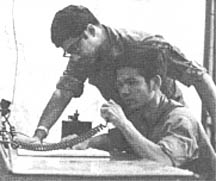 |
Page 8 TROPIC LIGHTNING NEWS December 15, 1969
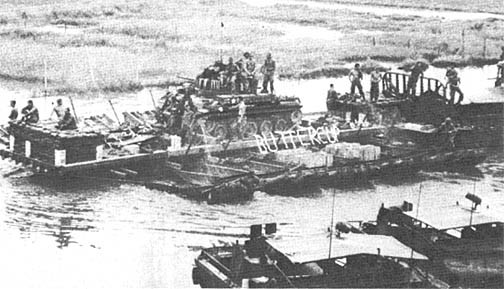 |
| FINEST SHIP IN THE ARMY - Moving out for a day patrol, HMS Buttercup is towed from the docks at Tra Cu by Navy boats. The Buttercup, manned by Wolfhounds of the 1st Battalion, 27th Infantry, patrols the Vam Co Dong River. (Photo by SP4 Frank Rezzonico) |
A Floating Patrol Base
Vam Co Dong Man-O'-War
By SP4 FRANK REZZONICO
CU CHI - What weighs 70 tons, carries a full crew of men, puts out the
firepower of a patrol base and floats?
Give up? The HMS Buttercup, of course.
"Home-Made Ship" Buttercup was nicknamed by the men of Delta Company, 1st
Battalion, 27th Infantry, commanded by Captain John French of Paris, Tenn. It's
a floating patrol base, with a duster, two bunkers and sleeping space for the
craft's crew perched on an engineer raft 60 feet long and 20 feet wide.
The Buttercup was built by the 65th Engineer Battalion on the Vam Co Dong
River at Hiep Hoa Sugar Mill. First Lieutenant Leslie Nishimura of Hilo,
Hawaii, the duster crew commander, and his men put the duster on the craft.
FROM THE Sugar Mill, the HMS Buttercup was towed by two Navy landing craft to
the Navy base at Tra Cu.
The Buttercup is manned by the duster crew, radar men, and eight infantrymen
of Delta Company. The craft is towed from the docks at Tra Cu during the day
for patrolling along the Vam Co Dong and is used for ambush patrols at night.
PRIVATE FIRST CLASS John Flourney of Richmond, Va., a radar man assigned to
the Buttercup, says, "Working with radar on this craft is basically the same as
on land, except for the fact that there is more bunker protection in a patrol or
fire support base."
Another radar man, Private First Class Karl Katsl of Torrence, Calif.,
remarked, "For size, the unit puts out more firepower than a patrol base - and
faster."
Rangers Avoid NVA Clutches, Kill Seven
By SGT TONY CAMELIO
CU CHI - A six-man ambush patrol from Company F, 75th Infantry Rangers
miraculously escaped from the clutches of an unknown-sized enemy force in the
Crescent area, ten miles northeast of Tay Ninh. Seven enemy were killed.
The Rangers had been airlifted into the area not more than 45 minutes before
the action started. First Lieutenant Robert L. Palmer of Foreston, Miss.,
assistant platoon leader, said of the action, "We took turns putting out our
claymores, three men at a time, and as the second group was in the process, we
started to receive heavy machinegun and RPG fire from all directions."
SERGEANT Henry J. Lawrence of Syracuse, N.Y., the patrol leader, said, "We
fired back with everything we had, but the enemy fire became more intense."
THEN, AS SPECIALIST 4 Thomas G. Cahill of St. Albans, N.Y., said, "When the dustoff ship came in to extract our wounded, the firing miraculously stopped.
What makes it seem even more incredible is that we had to carry two of them to
the ship on stretchers which left the ship on the ground for over a minute. As
soon as the dustoff took off we started to receive heavy fire again. I don't
know why they stopped firing when the dustoff came in, but I'm sure glad they
did."
With the help of Centaur gunships who put out protective fire, a single ship
landed to extract the Rangers.
A sweep of the area on the following day by the 4th Battalion, 9th Infantry
uncovered the bodies of seven enemy soldiers.
Tomahawks Offer 3-Day R&R in 'Den'
By SGT BILL OBERHOLZER
TAY NINH - When a GI talks about a three-day R&R, he usually discusses the
advantages of sunning on the beaches of Vung Tau or Cam Ranh Bay. However,
everyone doesn't get the opportunity to go there, and the money it takes
sometimes discourages the individual.
Headquarters Company, 4th Battalion (Mechanized), 23d Infantry has solved
this problem somewhat by offering their troopers a three-day no-expenses R&R in
Tay Ninh base camp at the "Tomahawk Den" constructed solely for their use. The
den is equipped with a refrigerator (stocked with free, cold beer), television,
beds, and easy chairs. A horseshoe pit outside offers only part of the
entertainment available.
"THE TIME is completely theirs" said Captain Robert Renneisan of Mira Loma,
Calif., commander of Headquarters Company and the man behind the idea. "They
can go anywhere in the base camp and there is no reveille in the morning."
Specialist 4 Robert Wilson of Hazelitt, N.J., the company clerk, added, "The
purpose of the R&R hootch is to provide a few days of relaxation for the guys in
the field. They really deserve it."
The men are selected by their platoon leaders strictly on merit. The only
expense will be what the individual wants to spend.
SPECIALIST 4 Thomas Cleveland of Columbus, Ohio, member of the scout platoon
is presently on a three-day R&R. He comments, "It's a good chance to catch up
on sleep and get things squared away."
Specialist 4 Charles Smith of Richmond, Va., also of the scout platoon, adds,
"It's a good place to get away for awhile, to write some letters, and maybe to
call home."
Mortar's Site Mangled, 24 Rounds Recovered
By SGT K.C. CULLEN
TAY NINH - A 120mm mortar will do a lot of damage to most of the buildings
and bunkers of Tay Ninh base camp.
The enemy had planned to use 24 of the rounds against the home of the 1st
Brigade, but Regulars of the 3d Battalion, 22d Infantry put a crimp in the plan
with the help of a conscientious Vietnamese Civilian Irregular Defense Group at
the village of Trang Sup.
IN TWO separate instances, Bravo and Charlie Companies captured the rounds,
including their fuses and powder charges, before they could be dropped down a
tube.
Bravo found nine of the rounds when a small boy reported to his father that
he had seen some men burying something in a rice paddy. The father notified the
CIDG, which in turn got in touch with the Regulars, and the two units went out
to the freshly dug hole and came up with the new projectiles.
CHARLIE COMPANY found their cache in the same general area several days later
after a barrage against the base camp was thwarted by heavy counter-mortar
artillery fire. Fifteen more of the large rounds came out of the hole as a
platoon of Charlie Company swept the area of the mortar site.
Tower guard at Fire Support Base Washington, Specialist 4 James Knott of
Seattle, who eventually pinpointed the position from the flash of the enemy
tube, said, "Before I could even get a call in, the artillery was in the general
vicinity and no more rounds came from the location. It was easy to tell our
people where to go to find the unfired rounds."
| Way Back When You say you're getting so short that you no longer get mad when you discover that somebody stole your beef and potatoes and replaced it with ham and lima beans? So short that all you can do is smile when newcomers ask you how it was "way back in August?" The 1969 Tropic Lightning Yearbook will help you recall how it was way back then and will also show newcomers how it was back in those early days. The book has now gone to press and will be delivered to purchasers in February. Price is $5. See your Tropic Lightning Association unit representative. |
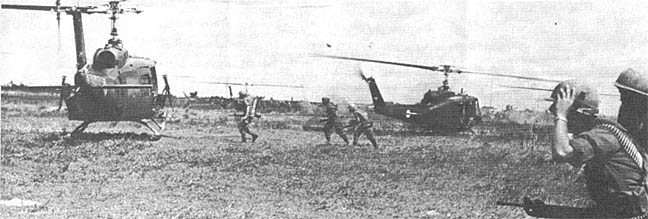 |
| HOLD EVERYTHING! Even steel helmets can be blown away by the backwash from helicopter rotor blades. These men from Charlie Company, 2d Battalion, 14th Infantry scurry aboard their choppers on their way to another landing zone. (Photo by SP4 Frank Ditto) |
Thanks to:
Karl Karlgaard, 2nd Bn., 27th Inf., and a Tropic Lightning News correspondent,
for sharing this issue,
Kirk Ramsey, 2nd Bn., 14th Inf. for creating this page.
This page last modified 01-31-2005
©2005 25th Infantry Division Association. All rights reserved.